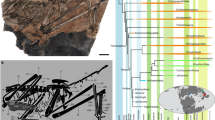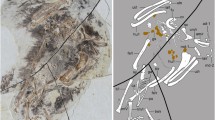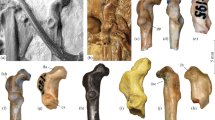Abstract
The early Miocene charadriiform bird Becassius charadriioides De Pietri and Mayr, 2012, from the Saint-Gérand-le-Puy area in France, was originally described as a member of uncertain affinities within the shorebird clade Scolopaci (jacanas, seedsnipe, painted-snipe, sandpipers, and allies). Following a re-assessment of the material attributed to this taxon and in the context of a larger comparative sample of extinct and extant charadriiform birds, we conclude that it is a member of the Glareolidae (pratincoles and coursers). We also demonstrate that certain elements, such as the coracoid, which were only tentatively referred to B. charadriioides, are very likely to belong to this taxon. We describe for the first time a tarsometatarsus that we tentatively attribute to this species. Based on the morphology of the humerus and other elements, it is not possible to associate Becassius charadriioides with any extant lineage within Glareolidae; it displays a combination of morphological features that can be presumed to be ancestral to Glareolidae based on outgroup comparisons and on the distinctiveness of B. charadriioides among other glareolids. The referral of Becassius charadriioides to Glareolidae bridges a gap in the evolutionary history of the clade, attesting to the presence of members of this clade in Europe during the earliest Miocene. Additionally, we provide a review of the fossil record of Glareolidae and re-assess some of the oldest fossils to have been attributed to this group.



Similar content being viewed by others
References
Baker, A.J., S.L. Pereira, and T.A. Paton. 2007. Phylogenetic relationships and divergence times of Charadriiformes genera: multigene evidence for the Cretaceous origin of at least 14 clades of shorebirds. Biology Letters 3: 205–210.
Ballmann, P.E. 1979. Fossile Glareolidae aus dem Miozän des Nördlinger Ries (Aves: Charadriiformes). Bonner Zoologische Beiträge 30: 51–101.
Baumel, J.J., and L.M. Witmer. 1993. Osteologia. In Handbook of Avian Anatomy: Nomina Anatomica Avium, vol. 2, eds. J.J. Baumel, A.S. King, J.E. Breazile, H.E. Evans, and J.C. Vanden Berge, 45–132. Cambridge: Nuttall Ornithological Club (= Publications of the Nuttall Ornithological Club 23).
Brehm, C.L. 1831. Handbuch der Naturgeschichte aller Vögel Deutschlands. Ilmenau: B.F. Voigt.
Brodkorb, P. 1985. Preliminary report on Pliocene/Pleistocene birds of East Africa. In Acta XVIII Congressus Internationalis Ornithologici, Moscow, August 16–24, 1982, vol. 1, 174–177. Moscow: Nauka.
Cohen, C. 2011. The phylogenetics, taxonomy and biogeography of African arid zone terrestrial birds: the bustards (Otididae), sandgrouse (Pteroclidae), coursers (Glareolidae) and Stone Partridge (Ptilopachus). Unpublished PhD thesis. Cape Town: University of Cape Town.
De Pietri, V.L., and G. Mayr. 2012. An assessment of the diversity of early Miocene Scolopaci (Aves, Charadriiformes) from Saint-Gérand-le-Puy (Allier, France). Palaeontology 55: 1177–1197.
De Pietri, V.L., and R.P. Scofield. 2014. The earliest European record of a Stone-curlew (Charadriiformes, Burhinidae) from the late Oligocene of France. Journal of Ornithology 155: 421–426.
De Pietri, V.L., L. Costeur, M. Güntert, and G. Mayr. 2011a. A revision of the Lari (Aves, Charadriiformes) from the early Miocene of Saint-Gérand-le-Puy (Allier, France). Journal of Vertebrate Paleontology 31: 812–828.
De Pietri, V.L., A. Manegold, L. Costeur, and G. Mayr. 2011b. A new species of woodpecker (Aves; Picidae) from the early Miocene of Saulcet (Allier, France). Swiss Journal of Palaeontology 130: 307.
De Pietri, V.L., R.P. Scofield, A.J.D. Tennyson, S.J. Hand, and T.H. Worthy. 2016a. Wading a lost southern connection: Miocene fossils from New Zealand reveal a new lineage of shorebirds (Charadriiformes) linking Gondwanan avifaunas. Journal of Systematic Palaeontology 14: 603–616.
De Pietri, V.L., R.P. Scofield, S.J. Hand, A.J.D. Tennyson, and T.H. Worthy. 2016b. Sheathbill-like birds (Charadriiformes: Chionoidea) from the Oligocene and Miocene of Australasia. Journal of the Royal Society of New Zealand 46: 181–199.
De Pietri, V.L., R.P. Scofield, G.J. Prideaux, and T.H. Worthy. 2018. A new species of lapwing (Charadriidae: Vanellus) from the late Pliocene of central Australia. Emu-Austral Ornithology 118: 334–343.
Dickinson, E.C., and J.V. Remsen. 2013. The Howard and Moore Complete Checklist of Birds of the World, vol. 1. Eastbourne: Aves Press.
Feakins, S.J., and P.B. Demenocal. 2010. Global and African regional climate during the Cenozoic. In Cenozoic mammals of Africa, ed. L. Werdelin, 45–55. Los Angeles: California University Press.
Göhlich, U.B. 2017. Catalogue of the fossil bird holdings of the Bavarian State Collection of Palaeontology and Geology in Munich. Zitteliana 89: 331–349.
Harrison, C.J.O., and C.A. Walker. 1977. Birds of the British Lower Eocene. Tertiary Research, Special Paper 3: 1–52.
Huxley, T.H. 1867. On the classification of birds; and on the taxonomic value of the modifications of certain of the cranial bones observable in that class. Proceedings of the Zoological Society of London 1867: 415–471.
Jánossy, D. 1991. Late Miocene bird remains from Polgárdi (W-Hungary). Aquila 98: 13–35.
Kessler, E. 2009. New results with regard to the Neogene and Quaternary avifauna of the Carpathian Basin: Part II. Földtani Közlöny 139: 251–271.
Ksepka, D.T., J.A. Clarke, and L. Grande. 2011. Stem Parrots (Aves, Halcyornithidae) from the Green River Formation and a Combined Phylogeny of Pan-Psittaciformes. Journal of Paleontology 85: 835–852.
Linnæus, C. 1758. Systema naturӕ per regna tria naturӕ, secundum classes, ordines, genera, species, cum characteribus, differentiis, synonymis, locis. Tomus I. Editio decima. Holmiæ [= Stockholm]: Laurentius Salvius.
Livezey, B.C. 2010. Phylogenetics of modern shorebirds (Charadriiformes) based on phenotypic evidence: analysis and discussion. Zoological Journal of the Linnean Society 160: 567–618.
Maclean, G.L. 2014. Family Glareolidae. In HBW and Birdlife International illustrated checklist of the birds of the world. Volume I: Non-passerines, eds. J. del Hoyo, and N.J. Collar. Barcelona: Lynx Edicions.
Maclean, G.L., and A. Bonan. 2018. Coursers, Pratincoles (Glareolidae). In Handbook of the Birds of the World Alive, eds. J. del Hoyo, A. Elliott, J. Sargatal, D.A. Christie, and E. de Juana. Barcelona: Lynx Edicions.
Maclean, G.L., and G.M. Kirwan. 2019. Australian Pratincole (Stiltia isabella). In Handbook of the Birds of the World Alive, eds. J. del Hoyo, A. Elliott, J. Sargatal, D.A. Christie, and E. de Juana. Barcelona: Lynx Edicions.
Mayr, G. 2000. Charadriiform birds from the early Oligocene of Céreste (France) and the middle Eocene of Messel (Hessen, Germany). Geobios 33: 625–636.
Mayr, G. 2002. On the osteology and phylogenetic affinities of the Pseudasturidae—lower Eocene stem-group representatives of parrots (Aves, Psittaciformes). Zoological Journal of the Linnean Society 136: 715–729.
Mayr, G. 2009. Paleogene Birds. Berlin, Heidelberg: Springer.
Mayr, G. 2011. The phylogeny of charadriiform birds (shorebirds and allies)–reassessing the conflict between morphology and molecules. Zoological Journal of the Linnean Society 161: 916–934.
Mayr, G. 2016. Variations in the hypotarsus morphology of birds and their evolutionary significance. Acta Zoologica 97: 196–210.
Mayr, G., and C.W. Knopf. 2007. A stem lineage representative of buttonquails from the Lower Oligocene of Germany–fossil evidence for a charadriiform origin of the Turnicidae. Ibis 149: 774–782.
Mayr, G., and R. Smith. 2001. Ducks, rails, and limicoline waders (Aves: Anseriformes, Gruiformes, Charadriiformes) from the lowermost Oligocene of Belgium. Geobios 2001: 547–561.
Milne-Edwards, A. 1863. Mémoire sur la distribution géologique des oiseaux fossiles et description de quelques espèces nouvelles. Annales des Sciences Naturelles 20: 132–176.
Milne-Edwards, A. 1867–1868. Recherches anatomiques et paléontologiques pour servir à l’histoire des oiseaux fossiles de la France, Vol. 1. Paris: Victor Masson et fils.
Mlíkovský, J. 2000. Early Miocene pratincoles (Aves: Glareolidae) from Dolnice, Czech Republic. Acta Societatis Zoologicae Bohemicae 64: 93–96.
Mourer-Chauviré, C., M. Pickford, and B. Senut. 2017. New data on stem group Galliformes, Charadriiformes, and Psittaciformes from the middle Eocene of Namibia. Contribuciones del MACN 7: 99–131.
Olson, Storrs L., and D.W. Steadman. 1979. The fossil record of the Glareolidae and Haematopodidae (Aves: Charadriiformes). Proceedings of the Biological Society of Washington 91: 972–981.
Olson, S.L., and K.G. Eller. 1989. A new species of painted snipe (Charadriiformes: Rostratulidae) from the early Pliocene at Langebaanweg, southwestern Cape Province, South Africa. Ostrich 60: 118–121.
Paton, T.A., A.J. Baker, J.G. Groth, and G.F. Barrowclough. 2003. RAG-1 sequences resolve phylogenetic relationships within charadriiform birds. Molecular Phylogenetics and Evolution 29: 268–278.
Pereira, S.L., and A.J. Baker. 2010. The enigmatic monotypic crab plover Dromas ardeola is closely related to pratincoles and coursers (Aves, Charadriiformes, Glareolidae). Genetics and Molecular Biology 33: 583–586.
Prum, R.O., J.S. Berv, A. Dornburg, D.J. Field, J.P. Townsend, E.M. Lemmon, and A.R. Lemmon. 2015. A comprehensive phylogeny of birds (Aves) using targeted next-generation DNA sequencing. Nature 526: 569–573.
Reichenbacher, B., W. Krijgsman, Y. Lataster, M. Pipperr, C.G. Van Baak, L. Chang, D. Kälin, J. Jost, G. Doppler, D. Jung, and J. Prieto. 2013. A new magnetostratigraphic framework for the Lower Miocene (Burdigalian/Ottnangian, Karpatian) in the North Alpine Foreland Basin. Swiss Journal of Geosciences 106: 309–334.
Roberts, A. 1922. Review of the nomenclature of South African birds. Annals of the Transvaal Museum 8: 187–272.
Strauch Jr., J.G. 1978. The phylogeny of the Charadriiformes (Aves): a new estimate using the method of character compatibility analysis. Transactions of the Zoological Society of London 34: 263–345.
Švec, P. 1980. Lower Miocene birds from Dolnice (Cheb Basin), western Bohemia. Časopis pro Mineralogii a Geologii 25: 377–387.
Wetmore, A. 1930. Two fossil birds from the Miocene of Nebraska. The Condor 32: 152–154.
Zelenkov, N.V. 2017. Revision of non-passeriform birds from Polgárdi (Hungary, Upper Miocene): 3, Neoaves. Paleontological Journal 51: 203–213.
Acknowledgements
We thank N. Zelenkov (Borissiak Paleontological Institute, Russian Academy of Sciences) for providing photos of Glareola neogena. We also thank J. Mlíkovský (Národní Muzeum, Praha), L. Costeur and M. Schneider (NMB), J. Cooper (NHMUK Tring), L. Steele (NHMUK), A. Tennyson (NMNZ), P. Horton (SAMA), H. James and M. Florence (USNM), C. Mehling and P. Sweet (AMNH), J. Cundiff and K. Eldridge (MCZ), for access to comparative material and fossil specimens. We are grateful to reviewers N. Zelenkov and A. Louchart, and Associate Editor U. Göhlich for their comments. This research was supported by a grant [16-CTM-001] from the Marsden Fund Council from New Zealand Government funding, managed by the Royal Society Te Apārangi.
Author information
Authors and Affiliations
Corresponding author
Additional information
Handling Editor: Ursula Göhlich.
Rights and permissions
About this article
Cite this article
De Pietri, V.L., Mayr, G. & Scofield, R. Becassius charadriioides, an early Miocene pratincole-like bird from France: with comments on the early evolutionary history of the Glareolidae (Aves, Charadriiformes). PalZ 94, 107–124 (2020). https://doi.org/10.1007/s12542-019-00469-8
Received:
Accepted:
Published:
Issue Date:
DOI: https://doi.org/10.1007/s12542-019-00469-8




